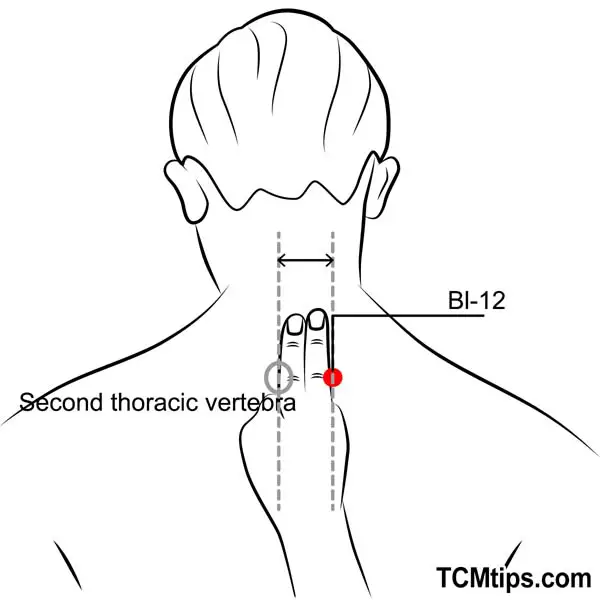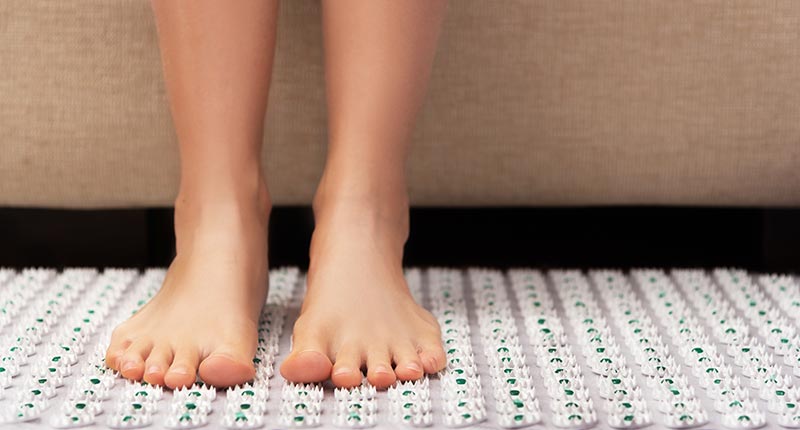When my allergy season came around, I used to watch the beautiful blooming flowers with horror as I stayed indoors. My asthma is often triggered by high pollen levels, and as a result, I couldn’t enjoy interacting with the beautiful spring scenery in my area. Sure, inhalers would help if I started having an asthma attack, but I hated the panic that I felt at the onset of each episode. I also wanted to enjoy more independence from my inhaler without building a reliance on any other medication. This was a recurring reality for me until I discovered acupressure points for asthma.
I have always been interested in natural forms of medicine that are rooted in historical methods of treatment. Having experienced the benefits of acupressure and acupuncture points in the past, I was delighted to discover points specific to managing my asthma. I can’t believe this natural, relaxing, and effective treatment option wasn’t recommended to me first! After my own positive experience of using asthma acupressure points and receiving joyful asthma acupressure reviews from friends, I knew I had to share this powerful secret with the millions of other individuals suffering from asthma!
If you are looking to treat your asthma in a way that is natural, simple, and effective, then read on to discover the 6 pressure points for asthma that will change your life!
Science Supports Acupressure Points For Asthma.

With roots in ancient Chinese medicine, acupressure and acupuncture have thousands of years of historical records supporting their benefits. These treatments have been continuously refined, and their success has kept them relevant until the present day.
If all of that history is not powerful enough to persuade you to believe in the benefits of using acupressure points for asthma, then maybe some modern research will suit your preferences.
With thousands of individuals raving about the asthma relief they experienced from pressure point treatments, scientists couldn’t help but start studying the matter. Doctors, researchers, and acupuncture practitioners alike have all witnessed the impact this treatment has on asthma management.
In comparison to modern medications and other invasive treatments of asthma, acupressure has been found to have far fewer adverse effects. It is also the only treatment option available to all individuals regardless of their income or the severity of their condition since it can be performed on one’s self.
Science has supported the general use of acupressure and acupuncture as a way to treat internal aspects of the body through external points, making this a perfect treatment method for asthmatic lungs. On a more specific level, one study showed an 18.5-fold improvement in the asthma severity test scores of test subjects after an 8-week treatment of acupuncture points for asthma. In the same study, it was found that subjects who received 8 weeks’ worth of treatment focused on acupressure for asthma improved in comfort and symptom management by a significant amount.
Other studies have shown that using a massage for asthma treatment was an effective method for children suffering from this condition. This suggests a defiant connection between the stimulation and relaxation of the outer body with lung function. Science continues to explore this field in hopes of discovering more promising correlations, but ongoing research doesn’t mean you have to wait to try this treatment out.
Should I Try Treating My Asthma With Acupressure?
I highly recommend that you give acupressure a try if you are suffering from asthma, and I am not alone. Many practitioners, other asthma sufferers, and doctors recommend trying this noninvasive method of treatment since it is unlikely to have any negative side effects.
There really is no harm in giving pressure points for asthma a try. Over time it can reduce your need for an inhaler, although you should always carry one just in case, and it will help you reduce your asthma-related discomfort. That means more walks on spring days, fewer asthma-related hospital visits, and less money spent on asthma-related treatments.
Let’s take a look at how you can get started using acupressure for your lung health.
How To Start Using Asthma Acupressure Points.

Like most methods of treatment, it is best to understand how to perform acupressure before diving in. There are numerous pressure points in the body, but the ones you want to focus on for asthma treatment are in very specific places.
Lucky for you, I have compiled the 6 most impactful pressure points for asthma in the list below! After reviewing and looking up pictures of these pressure points, you should be ready to give them a try. Be gentle but firm and stay aware of how these points feel when you work on them. Treat each point as often as you would like, as long as you are not damaging the skin or tissue in these areas from excessive treatment.
Work these points at least twice a week, and in a few weeks, you should start to notice relief from your asthma symptoms. If you like what you feel, then you can always schedule an asthma acupuncture appointment with a trained professional.
Now let’s take a look at my top acupressure points for asthma relief!
The Six Acupressure Points For Asthma That Will Change Your Life!
1. Acupoint: Bl-12 (Other Names: Urinary Bladder-12/Feng Men/Wind Gate)

This point falls into the bladder channel. However, its location is far from the bladder. This channel is branched and spans the length of the body from the head, down the spine, to the feet.
Being in close proximity to the spine and its many nerves, the bladder channel points are effective when it comes to treating musculoskeletal disorders. This is a crucial part of information related to this point’s functionality, considering that the lungs are controlled by subconscious muscular activity.
This point is especially effective for treating asthma symptoms in young children. It relaxes the neck, back, and shoulder, which leads to the relaxation of the lungs. Since stress, discomfort, and irritation can trigger asthma, this point of relaxation is a powerful method of treatment.

This point can be located on the upper back. To find it, run your fingers down the spine starting at the base of your neck. Each bump you feel is a protrusion marking each vertebra in your spine. You are looking for the second thoracic vertebrae, which should be the second distinguishable bump if you are running your hand down your spine, starting at the base of your neck. Position your fingers between this spinal protrusion and the one beneath it, then hold your pointer and middle finger together to measure 1.5 cun laterally from that spinal position.
This is the Bl – 12 point. Gently press down and rub in small circles in this area. If you are performing this treatment on a child, be sure to be gentle on their delicate skin and bones.
2. Acupoint: Bl-13 (Other Names: Urinary Bladder-13/Fei Shu/Lung Transporter)

This is another bladder channel point that just happens to support the musculoskeletal system and is most beneficial for children. This point differs from the Bl – 12 because it is directly related to supporting respiratory health.
To find the Bl – 13 pressure point for lungs, follow the same locating method as the Bl – 12 point, but move down one more vertebra to the 3rd spinal protrusion from the base of the neck. This point is, again, 1.5 cun from the spine in a lateral position. Gently rub this point in combination with the Bl – 13 point for best results.
3. Acupoint: Ren-22 (Other Names: The Conception Vessel-22/Tian Tu/Heaven Projection)
The Ren – 22 point is a part of a line of pressure points that run up the center of the chest. It makes the list due to its powerful impact on the lungs. For years this point has been used to calm the lungs, reduce mucus that can restrict breathing, and improve regular lung function. All of these effects make the Ren – 22 point impressively effective when conducting acupressure for lungs.
This point can be found quite easily if you run your fingers down the front of your neck and stop where your collar bones make a central indentation. This is your suprasternal fossa, and Ren – 22 can be located directly in the center of this divot. The location of this point is directly above the esophagus, so massage it firmly but gently to avoid irritating the airway.
Together with the lu 9 acupuncture point, practitioner commonly use these acupoints to relieve cough, phlegm, and nasal congestion
4. Acupoint: Ren-17 (Other Names: The Conception Vessel-17/Shan Zhong/Middle of the Chest)

Ren – 17 is part of the same line as Ren – 22, but it is significantly lower on the chest. This pressure point for the lungs works wonders in conjunction with Ren – 22. It has the added benefit of clearing fullness of the lungs, a sensation commonly felt with asthma flare-ups, and it reduces pain in the lungs. This is my go-to comfort point when my asthma is irritating me.
To activate this asthma acupressure point, first, locate your sternum. If your chest is rather flat, then you can use your nipples as a reference for the lateral location of this point on your sternum. Another method is to locate the 4th and 5th ribs on your chest and guide your hand to the central area of your sternum between these points. Once you are in that general area, rub gently until you locate tenderness or a light depression in your sternum, and that should be your Ren – 17 acupoint! Activate it through light pressure, considering that there is not much tissue between your skin and this point.
Ren-17 is also one of the 9 pressure points for upper back pain I’ve learned from my therapist.
5. Acupoint: LU-7 (Other Names: Lung-7/Lie Que/Broken Sequence)
LU stands for lung channel, so it’s no wonder why this point made the list. This is considered to be the exit point of the lung. Its activation opens, regulates, and strengthens the lungs for improved breathing. These aspects have made it a therapeutic asthma acupressure point of choice for thousands of individuals.
This point is surprisingly located near the wrist rather than the chest. It can be found by holding out both hands. Interlock your hands in a way where only the creases of the thumbs are interlocked, causing one palm to face up and the other to face down towards each other. Keep your fingers straight, and you will notice that your index finger lands directly on a grove that is slightly past your wrist on the side where your thumb is. You will feel a bone on the outside of your arm, be sure to maintain pressure in the grove in a manner that is more central than radial.
You can also use LU-7 with the third eye acupressure point to repair your taste and smell loss due to illness.
6. Acupoint: LU-10 (Other Names: Lung-10/Yu Ji/Fish Border)
This lovely point is on the same path as LU – 10. However, it is closer to the hand. This point has been known to reduce chest pain and clear the throat with a cooling effect. We often forget that asthma has an effect on the throat as well, so this point is a great option to treat the entire respiratory system.
Finding the LU – 10 point is rather simple. Hold your hand facing palm up, and then locate the lower meatier part of your thumb, which is connected to your palm. In this area, you will feel a long bone. The LU – 10 point is located mid-way up that bone. Since this area is more muscled, you can apply firm acupressure to this point to receive its cooling and healing effects!
Interestingly, LU-10 is also an excellent acupressure point for snoring problem!
 P. Sze
P. Sze 



















